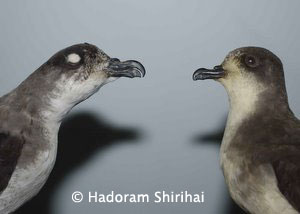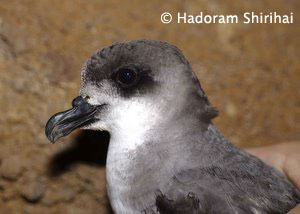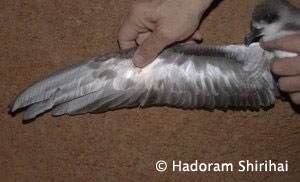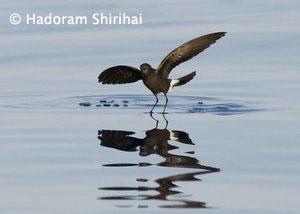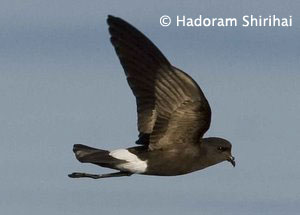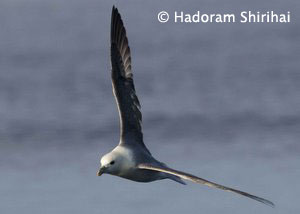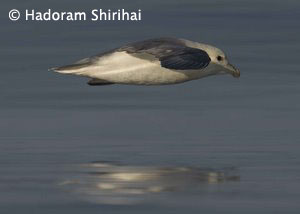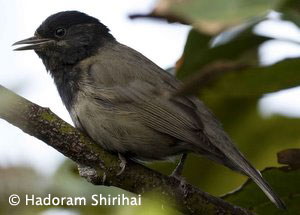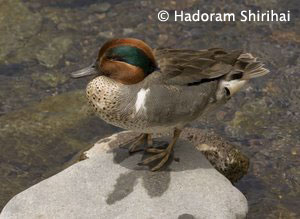Madeira petrel photo expedition - the desire & challenge to experience the enigmatic Zino's Petrel at sea, by Hadoram Shirihai
MADEIRA PETREL PHOTO EXPEDITION
The desire and challenge to experience the enigmatic Zino’s Petrel at sea
by Hadoram Shirihai
A report of April 2008 Expedition
Major part (at sea) of the following report is originally published in the Birding World (issue: 21. 6, pp 282-288), the essential magazine for WP birding discoveries (for obtaining hard copies of the paper and yearly subscription log to www.birdingworld.co.uk)
"I reached the island of Madeira on 21st April 2008, aiming to spend a few days trying to see and photograph Zino’s Petrel Pterodroma madeira at sea. Nowadays, Zino’s Petrel can be seen (or mostly heard) on organised and specially permitted nocturnal tours to the breeding sites in the high mountains of Madeira, but there are still probably fewer than ten records of claimed Zino’s Petrels identified and separated from Fea’s Petrels P. feae at sea – if any at all!
In a previous visit to Madeira, at the end of May 2003, Hans Jornvall and I had the privilege of visiting the breeding locality at night and participating in the ringing of Zino’s Petrels by Frank Zino himself. Frank’s dedicated conservation work on the petrels is to be greatly respected. During that visit, Frank and I sailed south of the island on 1st June, attempting to see Zino’s Petrel at sea. Zino’s Petrel is, of course, extremely difficult to separate from the more numerous Fea’s Petrel, which breed very close to Madeira, on the island of Bugio (one of the Desertas islands).
It is important to say at this point that Magnus Robb and Killian Mullarney (2008) treat the Pterodroma petrels of Bugio as a distinct species — Desertas Petrel P. deserta) — separate from Fea’s Petrel P. feae of the Cape Verde Islands, based mainly on vocalizations and breeding phenology. Although variable, Desertas birds have on average the deepest bill of the three North Atlantic gadfly petrels, the bill of (Cape Verde) Fea’s being somewhat intermediate between Desertas and Zino’s Petrel. Further confirmation of this split is awaited and, to be consistent with former works, all further mentions of Fea’s in this article should be taken to mean both feae and deserta (i.e. one species, Fea's Petrel). However, it should be borne in mind that most direct comparisons actually refer to the geographically closer Desertas Islands population.
Zino’s Petrel is essentially smaller and lighter than Fea’s, with a smaller bill. After seeing several Fea’s Petrels, we saw one bird which seemed to us to be smaller and lighter in build, but we could not be sure that we were judging the size correctly, so we left the identification simply as a Fea’s/Zino’s Petrel.
I had experienced an almost identical situation on an earlier seabird-orientated visit to Madeira, with my friend Lars Svensson and others, back in August 1999. On 8th August, from the Porto Santo ferry, at about 9.00am, one of five Fea’s/ Zino’s seen seemed smaller and more compact, but again we left the bird as unidentified. On the 2003 visit, I also studied the specimens of Zino’s and Fea’s Petrels in the pretty museum in Funchal, but this did not really help me obtain a better idea of how to separate the two species at sea.
With the lack of a breakthrough in this at-sea identification challenge, and because of my ongoing book projects (especially Shirihai & Bretagnolle in prep.), photographs of Zino’s Petrel at sea have become badly needed, so I undertook a special expedition in 2008. On the recommendation of Frank Zino, I chose the second half of April for my visit, as this is when Zino’s Petrels are already very actively visiting their breeding sites in the Madeira highlands, but the Fea’s Petrels P. (feae) deserta of nearby Bugio are not yet visiting theirs (they normally visit their breeding sites from mid May onwards). Ned Brinkley (2004) also suggested that the end of April should be the best time, for the same reason and, on his visit at this time of year, he successfully observed and described a bird that I was convinced was indeed a Zino’s Petrel. I should add here that I invited several of my friends on this 2008 expedition, but unfortunately they could not join me and could only wish me success. However, Brian Small reported that, some years back, he had also encountered a Fea’s/Zino’s which seemed to be small, and Killian Mullarney sent me images of an apparently small billed Fea’s/Zino’s Petrel that he had photographed off Madeira, while Catarina Fagundes (see also below) also showed me images of a suspected Zino’s she had photographed at sea off Madeira (although recent examination of these has suggested that the bill size and wing shape are inconclusive for Zino’s). Furthermore, Michael Tove (2001) and Francis Zino et al. (2008), in their excellent papers, described characters that could serve to identify Zino’s at sea, but I wanted actually to test these ideas in the field. Thus, these valuable publications and my pre-voyage correspondences made me even more enthusiastic about my upcoming mission in Madeiran waters....
The voyage plan
Frank Zino recommended collaborating with Madeira Wind Birds, a birding company run by Catarina Fagundes and Hugo Romano, and thus they became the principle organizers of the expedition. Both are young and enthusiastic Madeirans with an exceptional knowledge of their island’s avifauna, and they made my visit very enjoyable and successful. Hugo prepared the chum for my visit some days before my arrival, and Catarina joined the voyage on 23rd-24th April.
The plan was first to explore the far, deep waters south of Madeira by fast motorboat on 22nd April, and then to take a combined sail/motor boat for another two periods of two days each (23rd-24th & 25th-26th), mainly to explore the waters to the southeast of Madeira. Thus a total of five days at sea was planned, and this was divided as follows:
22nd April: Using the MV Katherine B, run by Peter Bristow and Norberto Silva, a 40-foot motor boat originally built and commissioned by the Royal Navy as a gunboat for use in Abu Dhabi. This boat proved to very good for covering long distances, and Peter and Norberto proved to be extremely good at spotting seabirds at great distances; they were very friendly and helpful, as well as being keen to learn about the birds and to operate the chum. Peter uses the Katherine B mostly for catching marlins, which he tags and releases, and I found this to be a most positive point in their attitude to marine conservation. On that day, we travelled up to about 28 miles south of Madeira. The weather was very calm, with an almost flat sea. The most interesting seabirds observed are listed below.
23rd-24th April: Using the very new, 40-foot sailing/motorboat, Aquaholic, run by the local Marco Sousa. This boat has a very good set of sails and an engine. Marco operated the boat with Vitor Nóbrega, and both are very experienced sailors with good international records in major competitions. The boat proved to be extremely good and stable even in the quite rough weather (with up to about a 20 knot wind) that developed during these two days. On the night of 23rd-24th, we planned to overnight in the shelter of the Desertas Islands but, due to the direction of the wind, we could not find a safe anchorage, so we returned to shelter off the eastern side of Madeira, from where we continued our voyage on the 24th. The most interesting seabirds observed are detailed below, including a description of the Zino’s Petrel seen on the 23rd (as is the chumming technique used during the voyage).
25th-26th April: I planned another two days at sea for these days, but these had to be cancelled due to very strong winds. Thus, I used the time in these two days for some land-birding which was to prove highly successful: a full account of my land birding, included the rarely photographed Melanistic Blackcap Sylvia atricapilla heineken, is detailed below.
Chum
The chum used on the 22nd consisted of fish waste (heads, guts etc) soaked in sardine oil and then placed in an onion-bag and towed behind the boat. On 23rd-24th, we used about 150kg of chum of grated fish waste mixed with used cooking oil (since we could not find fish or sardine oil) and then frozen into 10kg blocks. By using frozen blocks, the offal floats for a substantial period, permitting the petrels to take the food from the surface before it sinks. I was surprised to find two major differences in response to the two types of chum: to the fish placed in the onion-bag, virtually only storm petrels were attracted, but to the floating frozen blocks we received a constant stream of visits from Cory’s Shearwaters — and to this chum we also attracted the Zino’s Petrel. It seems that the larger seabirds, and in particular the Pterodroma petrels, are more easily attracted to this floating food, permitting more prolonged and closer views.
The Zino’s Petrel
On the late-afternoon/evening of 23rd April we chummed about 35 miles (c.56km) southeast of the easternmost tip of Madeira, which is about 55 miles (c.90km) from the Zino’s Petrel breeding locality at Pico do Areeiro on Madeira. My reason for chumming here and at this time was firstly that if Zino’s Petrels were returning to their breeding site from the east in the evening they might hit this location at that time. Secondly, I thought that Porto Santo and especially the Desertas Islands, might provide ‘leading lines’ into our chumming position, as marked on the map below.
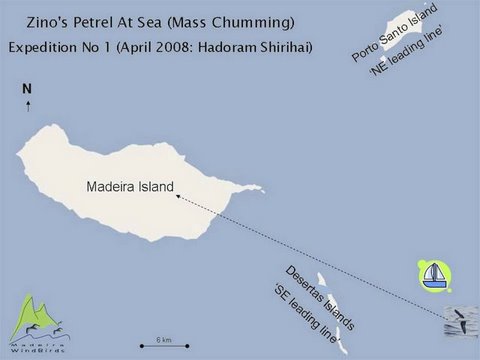
A schematic diagram of the positioned chum slick on the 23rd April 2008 and where the Zino’s Petrel was observed: see main text for explanation on how it worked.
Due to the rather choppy conditions, rather than just drifting next to the floating chum, we were forced to circle it at a distance of about 100-200m. At 7.40pm, as we turned the front of the boat to face the chum, Victor spotted some bird action above the block and, using my binoculars, I immediately located a bird that I could readily identify as a Zino’s Petrel (see below). The whole observation lasted about one to two minutes, with the bird zig-zagging above the frozen chum block over and over again (8- 10 times). It was also seen being chased by two Yellow-legged Gulls. These were not present a few minutes earlier, so it seems that while we were making our loop around the chum and having our backs to the floating frozen blocks, the petrel slipped in and its active feeding flight attracted the two gulls too. I realised that with our rather distant position (and with the very bumpy sea) I was not going to be able to obtain good photographs of the bird, so I decided not even to try to lift my heavy camera, but just to try to learn as much as possible about the features and flight behavior of this so rarely watched species.
Identification
The advantage that I gained by making my trip in April is that any Fea’s/Zino’s Petrel observed at this time is presumably more likely to be a Zino’s rather than a Fea’s. However, I based my identification on features that I found I could detect reasonably easily, even in this quite brief observation. Since there are very few (or virtually no) unassailable records of Zino’s at sea, my observation should have considerable value for observers keen to know how Zino’s Petrel really appears at sea. Rather than provide a full description, I here itemize the key identification marks of my Zino’s Petrel.
Conclusion
A few points can be learned from this observation of a presumed Zino’s Petrel and some previous experiences with Fea’s. The first is that there is considerable variation in Fea’s (in size and plumage) and some are truly smaller overall and smaller-billed than others, or appear such, and superficially more like Zino’s, but only prior to actually seeing a Zino’s. If eventually you see a real Zino’s, and given a reasonable view (plus previous experience with Fea’s), it will be most likely prove to be quite straightforward to separate at sea, by its distinctly smaller size, rather shorter wings and more rounded wing-tips, and smaller (less deep) bill. Whilst I could not detect any reliable plumage characters to separate the Zino’s, the species perhaps has as a tendency to show a paler but more contrasting head pattern and especially more contrasting underwing markings. As highlighted above, however, even if such plumage features (and differences in the underwing) exist, it would probably be very difficult to detect them reliably at sea or from even good photographs since the constant changes of light and angles of view may limit their usefulness.
From my experience of Zino’s Petrel, I conclude that Zino’s Petrel can be a distinct and diagnosable species even at sea. However, since it appears to differ from Fea’s Petrel at sea mostly in size and slight structural differences, it is best to employ as much comparative size judgment as possible. My observation of this Zino’s at least in part supported the at-sea differences between Zino’s and Fea’s Petrels suggested by Tove (2001) and Zino et al. (2008).
- References:
- Brinkley, N. 2004. http://madeira.seawatching.net/files/Madeira2004_NB.pdf
- Clarke, T. 2006. Birds of the Atlantic Islands. (Illustrated by Chris Orgill and Tony Disley) Christopher Helm, London.
- Robb, M. & Mullarney, K. 2008. Petrels night and day. Poole.
- Shirihai, H. & Bretagnolle, V. In prep. Albatrosses, Petrels and Shearwaters of the World: a handbook to their taxonomy, identification, ecology and conservation. (Illustrated by John Cox.) A & C Black, London.
- Shirihai, H., G. Gargallo, and A. Helbig. (2001) Sylvia Warblers: Identification, taxonomy, and phylogeny of the genus Sylvia. Christopher Helm, London.
- Tove, M. 2001. Verification of suspected field identification differences in Fea’s and Zino’s Petrels. Birding World 14: 283–289.
- www.madeirabirds.com/madeira_birds
- Zino, F.; Biscoito, M. J. & Zino, P. A. 1995. Birds of the Archipelago of Madeira and the Selvagens new records and checklist. Bol. Mus. Mun. Funchal, 47 (262): 63-100.
- Zino, F., Brown, R. & Biscoito, M. 2008. The separation of Pterodroma madeira (Zino’s Petrel) from Pterodroma feae (Fea’s Petrel). Ibis 150: 326–333.
Final statements and acknowledgments: first I like to thank again to Francis Zino for information and great hospitality in my 2003 visit, and recently helping in editing this report with Catarina Fagundes and Hugo Romano. I like to use these lines to congratulate Catarina and Hugo for the incredible birding company, ‘Madeira Wind Birds’, that they have created in Madeira. Without their involvement the ‘Zino’s Petrel At Sea Photographic Expedition No 1’ could not be so successful. Indeed, I missed photographing the Zino’s Petrel, but we successfully for the first time managed to attract this enigmatic species on the chum slick and to test its distinctiveness at sea. I highly recommend the birding services by the experience and friendly attitude of ‘Madeira Wind Birds’.
Above I already mentioned the great contribution to my work in Madeira by locals Peter Bristow & Norberto Silva, as well as Tania Pestana, Vitor Nóbrega and Marco Sousa.
Francis Zino and Mike Tove kindly sent their useful and instructive comments on the earlier draft of the Birding World paper, while Tony Pym, Brian Small and Lars Svensson also briefly commented on the first edited manuscript. Killian Mullarney kindly provided highly instructive criticism and comments, most of which have been incorporated in this text. Even though we do not agree on everything in this article, we do broadly agree that the at-sea identification of Zino’s Petrel needs further study and would benefit from a rigorously objective analysis. I would like to thank to Richard Millington and Steve Gantlett (Birding World. www.birdingworld.co.uk) for their extensive editorial help and advice, and in encouraging my at-sea petrel studies in Madeira.
Finally, I would like to dedicate this pioneering at sea expedition in Madeira waters to the local people working hard in conserving the Zino’s Petrel, and in particular Francis Zino and his close team.
The future: Personally, I still need to photograph Zino's Petrel at sea, and with this in mind I am planning a further 10-day expedition in April 2009. Due to limited space, I can allow to take max two more photographers that will be willing to share equally the privat charter of the boat. The voyage will again be in collaboration with Madeira Wind Birds, and for further information please contact me".
Hadoram Shirihai/ Birding World/ Madeira Wind Birds © Copyright
Join Madeira Wildlife Monthly Newsletter. All the updates on your email every month.
